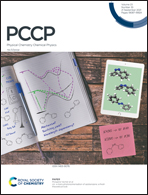Theoretical and experimental study on the O(3P) + 2,5-dimethylfuran reaction in the gas phase†
Abstract
In this work we report a joint experimental and computational study on the 2,5-dimethylfuran oxidation reaction in the gas phase initiated by atomic oxygen O(3P). The experiments have been performed by using vacuum-ultraviolet synchrotron radiation at the Advanced Light Source (ALS) of the Lawrence Berkeley National Laboratory (LBNL), at a temperature of 550 K and a pressure of 8 Torr. The experimental data were supported by quantum-chemical calculations along with a kinetic model, also taking into account the possible involvement of different magnetic states, performed in the framework of the RRKM theory. Propyne, acetaldehyde, methylglyoxal, dimethylglyoxal, 3-penten-2-one, 2,5-dimethylfuran-3(2H)-one, and 1,2-diacetyl ethylene have been identified as the main primary products arising under the conditions of the experiment. Our computational model suggests that these species can be formed at the concentration and branching ratio experimentally observed only in the presence of a non-negligible fraction of non-thermalized intermediates.



 Please wait while we load your content...
Please wait while we load your content...
